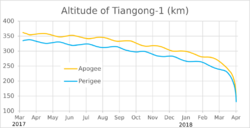| Display title | Astronomy:Orbital decay |
| Default sort key | Orbital decay |
| Page length (in bytes) | 14,845 |
| Namespace ID | 3024 |
| Namespace | Astronomy |
| Page ID | 423089 |
| Page content language | en - English |
| Page content model | wikitext |
| Indexing by robots | Allowed |
| Number of redirects to this page | 1 |
| Counted as a content page | Yes |
| Page image |  |
| HandWiki item ID | None |
| Edit | Allow all users (infinite) |
| Move | Allow all users (infinite) |
| Page creator | imported>LinXED |
| Date of page creation | 07:18, 6 February 2024 |
| Latest editor | imported>LinXED |
| Date of latest edit | 07:18, 6 February 2024 |
| Total number of edits | 1 |
| Recent number of edits (within past 90 days) | 0 |
| Recent number of distinct authors | 0 |
Description | Content |
Article description: (description)
This attribute controls the content of the description and og:description elements. | Orbital decay is a gradual decrease of the distance between two orbiting bodies at their closest approach (the periapsis) over many orbital periods. These orbiting bodies can be a planet and its satellite, a star and any object orbiting it, or components of any binary system. If left unchecked, the decay... |

